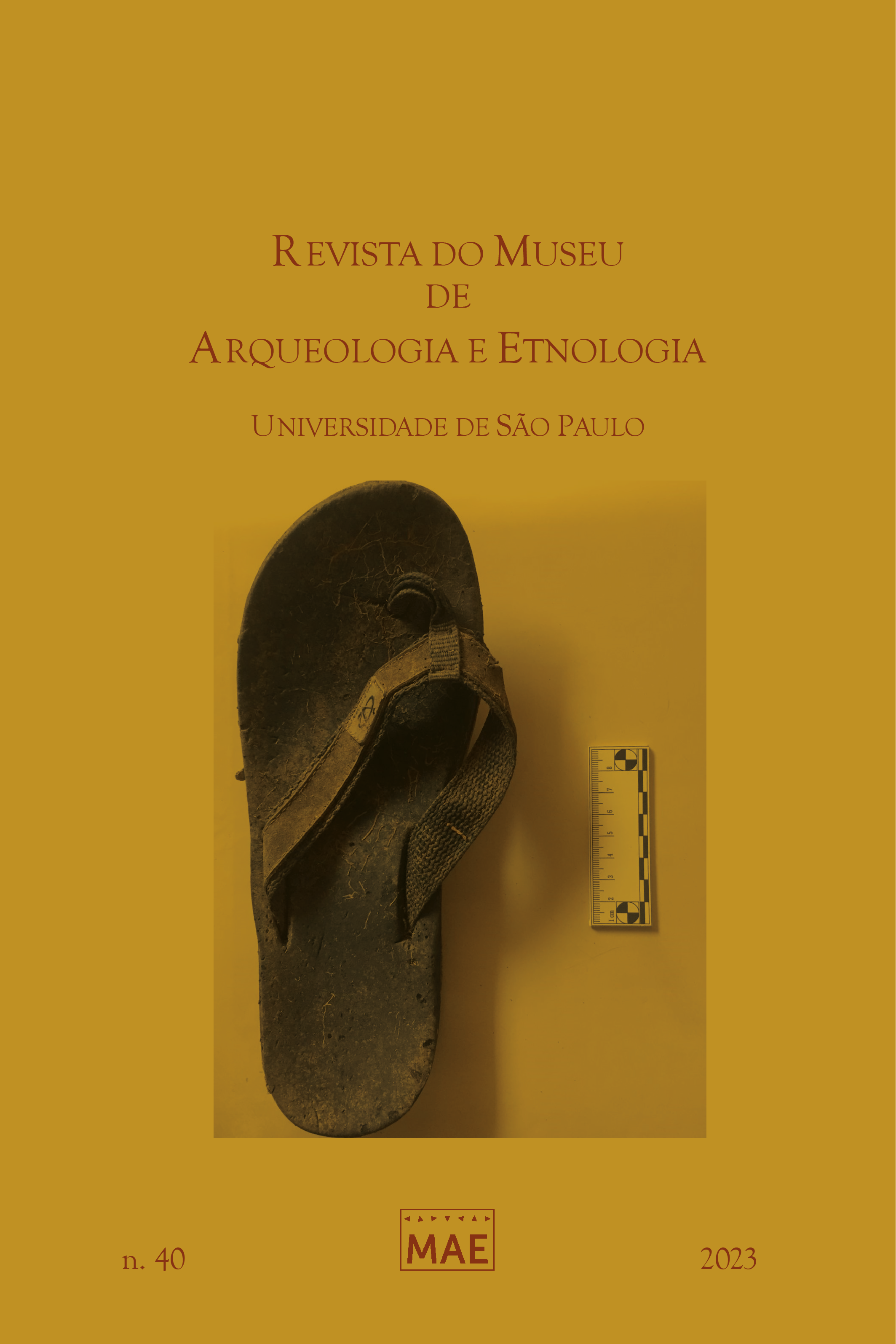As “ecologias” na arqueologia: bases teóricas para o estudo das interações entre pessoas e o ambiente
DOI:
https://doi.org/10.11606/issn.2448-1750.revmae.2023.205026Palavras-chave:
Interações pessoas-ambiente, Ecologia Cultural, Ecologia Comportamental, Ecologia Histórica, Teoria de Construção de Nichos, AmazôniaResumo
Este ensaio apresenta uma breve história das teorias antropológicas utilizadas para compreender as interações milenares entre as pessoas e o ambiente, particularmente em relação à arqueologia. Com destaque especial na região amazônica, pretende-se fornecer um panorama dos paradigmas principais, começando com a Ecologia Cultural da primeira metade do século XX, passando pelas abordagens paleoeconômicas e comportamentais da Nova Arqueologia, até chegar às contribuições mais recentes da Ecologia Histórica, da Teoria de Construção de Nichos e das perspectivas indígenas.
Downloads
Referências
Almeida, A. W. 2004. Terras Tradicionalmente Ocupadas: processos de territorialização movimentos sociais. Revista Brasileira de Estudos Urbanos e Regionais 6: 9-32.
Armstrong, C. G. et al. Anthropological contributions to historical ecology: 50 questions, infinite prospects. PLOS One 12: 1-26.
Arroyo-Kalin, M. 2017. Human niche construction and population growth in pre-Columbian Amazonia. Archaeology International 20: 122-136.
Balée, W. 1998. Historical Ecology: premises and postulates. In: Balée, W. (Ed.). Advances in Historical Ecology. Columbia University Press, New York, 13-27.
Balée, W. 2006. The research program of Historical Ecology. Annual Review of Anthropology 35: 75-98.
Basso, K. H. 1996. Wisdom Sits in Places: Landscape and language among the Western Apache. University of New Mexico Press, Albuquerque.
Binford, L. R. 1968. Post-Pleistocene adaptations. In: Binford, S. R.; Binford, L. R. (Ed.). New Perspectives in Archaeology. Aldine, Chicago, 313-341.
Bogaard, A. et al. 2021. Reconsidering domestication from a process archaeology perspective. World Archaeology 53: 56-77.
Bryant, V. M.; Holloway, R. G. 1983. The role of palynology in archaeology. In: M. S. Schiffer. (Ed.). Advances in Archaeological Method and Theory. Academic Press, New York, 191-223, v. 6.
Cabral de Oliveira, J. 2016. Mundos de roças e florestas. Boletim do Museu Paraense Emílio Goeldi: Ciências Humanas 11: 115-131.
Carneiro da Cunha, M. 2019. Antidomestication in the Amazon. Journal of Ethnographic Theory 9: 126-136.
Clark, J. D. G. 1952. Prehistoric Europe: The Economic Basis. Philosophical Library, New York.
Cronk, L. 1991. Human behavioural ecology. Annual Review of Anthropology 20: 25-53.
Crumley, C. L. 1994. Historical Ecology: Cultural knowledge and changing landscapes. School for Advanced Research Press, New Mexico.
Crumley, C. L. 2007. Historical ecology: integrated thinking at multiple temporal and spatial scales. In: Hornborg, A.; Crumley, C. L. (Ed.). The World System and the Earth System: Global Socioenvironmental Change and Sustainability since the Neolithic. Left Coast Press, Walnut Creek, 15-28.
David, B.; Thomas, J. 2008. Landscape archaeology: introduction. In: David B.; Thomas, J. (Ed.). Handbook of Landscape Archaeology. Routledge, London, 27-43.
Dennell, R. W. 1972. The interpretation of plant remains: Bulgaria. In: Higgs; E. S. (Ed.). Papers in Economic Prehistory. Cambridge University Press, Cambridge, 149-159.
Dyson-Hudson, R.; Smith, E. A. 1978. Human territoriality: an ecological reassessment. American Anthropologist 80: 21-41.
Erickson, C. L.; Balée, W. 2006. The historical ecology of a complex landscape in Bolivia. In: Erickson, C. L.; Balée, W. (Ed.). Time and Complexity in Historical Ecology. Columbia University Press, New York, 187-233.
Fausto, C.; Neves, E. G. 2018. Timeless gardens: deep indigenous history and the making of biodiversity in the Amazon. In: Sanz, N. (Ed.). Exploring Frameworks for Tropical Forest Conservation: Integrating natural and cultural diversity for sustainability, a global perspective. Unesco, Veracruz, 150-179.
Flannery, K. V. 1969. Origins and ecological effects of early domestication in Iran and the Near East. In: Ucko, P. J.; Dimbleby, G. W. (Ed.). The Domestication and Exploitation of Plants and Animals. Aldine, Chicago, 73-100.
Flannery, K. V. 1986. Guila Naquitz: Archaic foraging and early agriculture in Oaxaca, Mexico. Academic Press, New York.
Francisconi, M. J. 2006. Cultural ecology. In: Birx, H. J. (Ed.). Encyclopedia of Anthropology. Sage, London.
Halstead, P.; O’Shea, J. 1989. Introduction: cultural responses to risk and uncertainty. In: Halstead, P.; O’Shea, J. (Ed.). Bad Year Economics: Cultural responses to risk and uncertainty. Cambridge University Press, Cambridge, 1-7.
Heckenberger, M. J. 2005. The Ecology of Power: Culture, place, and personhood in the southern Amazon, A.D. 1000–2000. Routledge, London.
Heckenberger, M. J. et al. 2003. Amazonia 1492: pristine forest or cultural parkland? Science, 301: 1710-1714.
Higgs, E. S. 1972. Papers in Economic Prehistory. Cambridge University Press, Cambridge.
Hillman, G. C. 1972. Plant remains. In: Higgs, E. S. (Ed.). Papers in Economic Prehistory. Cambridge University Press, Cambridge, 182-188.
Hodder, I. 1978. The Spatial Organisation of Culture. Duckworth, London.
Ingold, T. 2000. The Perception of the Environment: Essays on livelihood, dwelling and skill. Routledge, London.
Isendahl, C.; Stump, D. 2016. Conclusion: Anthropocentric historical ecology, applied archaeology, and the future of a usable past. In: Isendahl, C.; Stump, D. (Ed.). The Oxford Handbook of Historical Ecology and Applied Archaeology. Oxford University Press, Oxford, 581-598.
Iversen, J. 1949. The influence of prehistoric man on vegetation. Danmarks Geologiske Undersoegelse 4: 6-25.
Kelly, R. L. 1995. The Foraging Spectrum: Diversity in hunter-gatherer lifeways. Smithsonian Institution Press, Washington.
Kopenawa, D.; Albert, B. 2013. The Falling Sky: Words of a Yanomami shaman. Belknap Press, Cambridge.
Krenak, A. 2019. Ideias para adiar o fim do mundo. Companhia das Letras, São Paulo.
Krenak, A. 2020. O amanhã não está à venda. Companhia das Letras, São Paulo.
Laland, K. N.; O’Brien, M. J. 2010. Niche construction theory and archaeology. Journal Archaeological Method Theory 17: 303-322.
Laland, K. N.; O’Brien, M. J. 2011. Cultural niche construction: an introduction. Biological Theory 6: 191-202.
Lewontin, R. C. 1983. Gene, organism, and environment. In: Bendall, D. S. (Ed.). Evolution from Molecules to Men. Cambridge University Press, Cambridge, 273-285.
McKey, D. et al. 2010. Pre-Columbian agricultural landscapes, ecosystem engineers, and self-organized patchiness in Amazonia. Proceedings of the National Academy of Scienced of the USA 107: 7823-7828.
Meggers, B. J. 1954. Environmental limitations on the development of culture. American Anthropologist 56: 801-824.
Meggers, B. J. 1975. Application of the biological model of diversification to cultural distributions in tropical lowland South America. Biotropica 7: 141-161.
Meggers, B. J. 1977. Vegetational fluctuations and prehistoric cultural adaptation in Amazonia: some tentative correlations. World Archaeology 8: 287-303.
Munduruku, J. B. 2019. Caminhos para o passado: Ocaõ, Agõkabuk e cultura material Munduruku. Trabalho de Conclusão do Curso no Programa de Arqueologia, Instituto de Ciências da Sociedade, Universidade Federal do Oeste do Pará, Santarém.
Odling-Smee, J.; Laland, K. N.; Feldman, M. W. 2003. Niche Construction: The neglected process in evolution. Princeton University Press, Princeton.
Outram, A. K.; Bogaard, A. 2019. Subsistence and Society in Prehistory: New directions in economic archaeology. Cambridge University Press, Cambridge.
Payne, S. 1972a. Partial recover and sample bias: the results of some sieving experiments. In: Higgs, E. S. (Ed.). Papers in Economic Prehistory. Cambridge University Press, Cambridge, 295-305.
Payne, S. 1972b. On the interpretation of bone samples from archaeological sites. In: Higgs, E. S. (Ed.). Papers in Economic Prehistory. Cambridge University Press, Cambridge, 49-64.
Posey, D. A.; Balée, W. 1989. Resource Management in Amazonia: Indigenous folk strategies. Advances in Economic Botany, New York Botanical Garden, New York.
Piperno, D. R.; Pearsall, D. M. 1998. The Origins of Agriculture in the Lowland Neotropics. Academic Press, New York.
Rindos, D. 1984. The Origins of Agriculture: An evolutionary perspective. Academic Press, London.
Santos-Granero, F. 1998. Writing history into the landscape: space, myth and ritual in contemporary Amazonia. American Ethnologist 25: 128-148.
Santos-Granero, F. 2004. Arawakan sacred landscapes. Emplaced myths, place rituals, and the production of locality in western Amazonia. In: Halbmayer, F.; Mader E. (Ed.). Kultur, Raum, Landschaft. Zur Bedeutung Des Raumes in Zeiten Der Globalität. Brandes; Apsel Verlag, Frankfurt, 93-122.
Science Panel for the Amazon. 2021. Amazon Assessment Report 2021. Disponível em: <https://bit.ly/3Ev89qn>. Acesso em: 24/02/2023.
Service, E. R. 1962. Primitive Social Organization: An evolutionary perspective. Random House, New York.
Shock, M. P.; Watling, J. 2022. Plantes et peuplement: questions et enjeux relatifs à la manipulation et à la domestication de végétaux au Pléistocène final et à l’Holocène initial au Brésil et em Amazonie. Brésil(s): Sciences humains et sociales 21: 1-27.
Silva, F. A.; Noelli, F. S. 2015. Mobility and territorial occupation of the Asurini do Xingu, Pará, Brazil: an archaeology of the recent past in the Amazon. Latin American Antiquity 26: 493-511.
Smith, B. D. 2016. Neo-Darwinism, niche construction theory, and the initial domestication of plants and animals. Evolutionary Ecology 30: 307-324.
Steward, J. 1946. Handbook of South American Indians. Volume 1: The Marginal Tribes. Smithsonian Institution, Washington.
Steward, J. 1955. Theory of Culture Change. University of Illinois Press, Chicago.
Steward, J. 2006. The concept and method of cultural ecology. In: Haenn, N.; Wilk, R. R. (Ed.). The Environment in Anthropology: A reader in ecology, culture and sustainable living. New York University Press, New York, 5-10.
Tilley, C. 1981. Economy and society: what relationship? In: Bailey, G.; Sheridan, A. (Ed.). Economic Archaeology. British Archaeological Reports, Oxford, 131-148.
Watkins, J. 2000. Indigenous Archaeology: American Indian values and scientific practice. Altamira Press, Walnut Creek.
Watling, J., Mayle, F. E.; Schaan, D. P. 2018. Historical ecology, human niche construction and landscape in pre-Columbian Amazonia: a case study of the geoglyph builders of Acre, Brazil. Journal of Anthropological Archaeology 50: 128-139.
White, L. 1959. The Evolution of Culture: The development of civilization to the fall of Rome. McGraw-Hill, New York
Whitehead, N. L. 1998. Ecological history and historical ecology: diachronic modelling versus historical explanation. In: Balée, W. (Ed.). Advances in Historical Ecology. Columbia University Press, New York, 30-40.
Winterhalder, B. 1986. Diet choice, risk, and food sharing in a stochastic environment. Journal of Anthropological Archaeology 5: 369-392
Winterhalder, B.; Smith, E. A. 2000. Analyzing adaptive strategies: human behavioral ecology at twenty-five. Evolutionary Anthropology 9: 51-72.
Zeder, M. A. 2012. The Broad Spectrum Revolution at 40: resource diversity, intensification, and an alternative to optimal foraging explanations. Journal of Anthropological Archaeology 31: 241-264
Downloads
Publicado
Edição
Seção
Licença
Copyright (c) 2023 Jennifer Watling

Este trabalho está licenciado sob uma licença Creative Commons Attribution-NonCommercial-NoDerivatives 4.0 International License.
Dados de financiamento
-
Fundação de Amparo à Pesquisa do Estado de São Paulo
Números do Financiamento 2017/25157-0


















